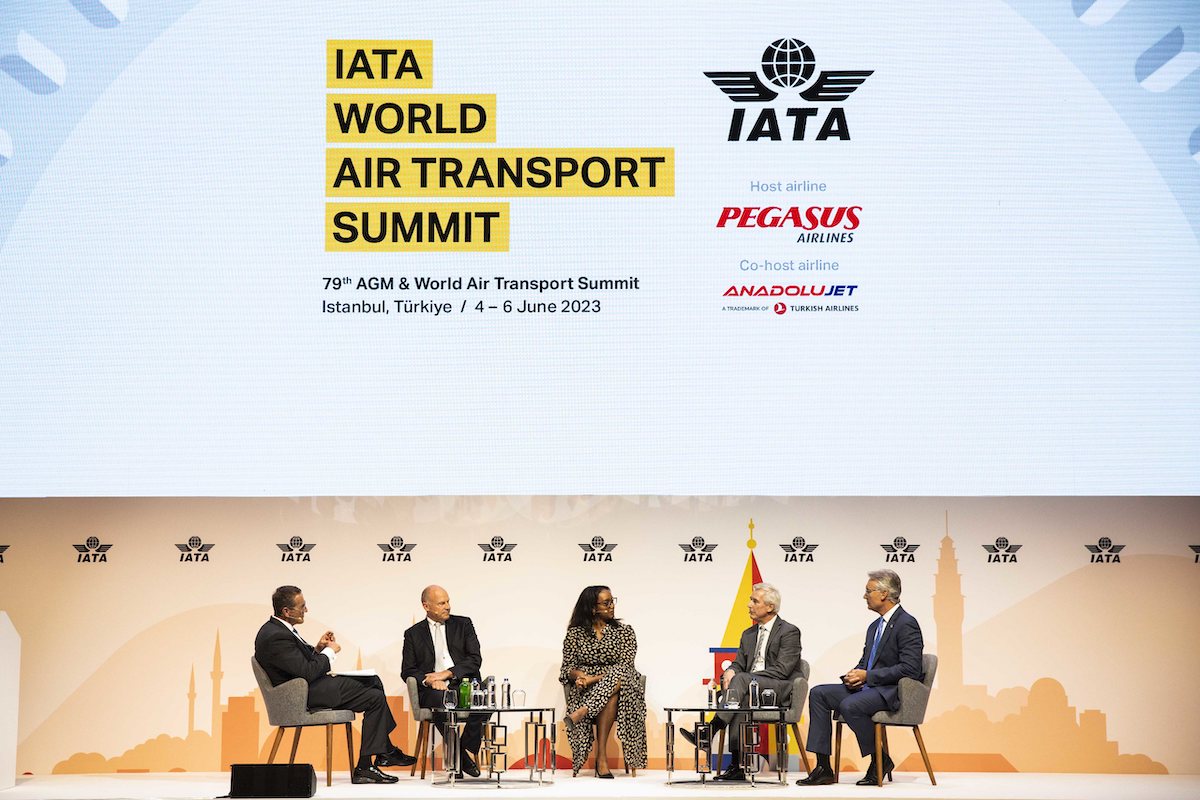Airline Execs Dismiss Slowdown Fears, Say It is 'Best Recession' Industry Ever Faced

Photo Credit: CNN's Richard Quest spoke with Air India CEO Campbell Wilson, RwandAir CEO Yvonne Manzi Makolo, Atlas Air CEO John Dietrich, and Air New Zealand CEO Greg Foran at the IATA Annual General Meeting in Istanbul. Flickr / Natalia Mroz/IATA
Business is good for airlines, except where it's not. That was the word in the halls and meeting rooms of the industry's largest annual gathering, the IATA Annual General Meeting, this week.
The organization has upped its airline financial outlook for the year to $22.4 billion in operating profits, a seven-fold increase from the $3.2 billion forecast in December. Lifted by continued travel demand strength and easing fuel prices. Full-year passenger traffic is expected to come in just 4 percent below its 2019 peak.
"Despite economic uncertainties, people are flying to reconnect, explore, and do business," IATA Director General Willie Walsh said at the event in Istanbul. "Airports are busier, hotel occupancy is rising, local economies are reviving, and the airline industry has moved into profitability."
But behind bullish numbers is a turbulent backdrop. The corporate travel recovery has stalled, economic concerns persist, aircraft production issues and delays continue, and a shortage of spare parts and engines has some airlines scrambling.
“In the U.S., we’re in a business recession, and consumer is just fine — consumer is strong,” United Airlines CEO Scott Kirby said in Istanbul.
Corporate travel revenue from large, managed accounts, has plateaued in the U.S. at between 75 and 80 percent of 2019 levels based on comments from executives at American Airlines, Delta Air Lines, and United. The airlines are already looking beyond the current summer season for the next potential step up in business travel. But that does not mean things are bad.
“If we’re in the middle of a recession, this is the best recession the airline industry has ever seen," United Chief Commercial Officer Andrew Nocella said. Asked about post-summer travel demand, when many think a slowdown could occur, and he pivoted from definitive comments to say United "remains optimistic" that it will meet its full-year pre-tax margin target of roughly 9 percent.
Emirates President Tim Clark was much more confident that the rest of 2023 will be good for airlines.
“For the next nine months we’re full. [But] what happens in 2024 is anyone’s guess," he said. For example, a mild recession in global markets could negatively affect the recovery but an end to Russia's war in Ukraine could be "another kickstart to the global economy."
But full planes and strong demand do not mean the yield party airlines have enjoyed since last year will continue. Qantas CEO Alan Joyce said airfares are "moderating" — or slowing from strong growth — in some markets, particularly those where capacity has recovered. He highlighted markets served by the airline's budget subsidiary, Jetstar, as places where yields were beginning to flatten.
New aircraft delays at Airbus and Boeing are proving both a boon and bane to airlines. On the positive side, it has helped hold industry capacity in check despite torrid demand, and contributed to the record high yields airlines are earning on many routes. Conversely, many carriers' inability to recover to pre-pandemic capacity levels at pace with the return of other expenses, like staffing, has reset costs to levels significantly higher than where they were in 2019.
"The A380 wouldn’t be flying if the 777[X] had been flying," Lufthansa Group CEO Carsten Spohr said. The group restarted flights on the Airbus superjumbo earlier in June to meet demand despite outlining plans to permanently retire the A380s in 2021.
The 777X, Boeing's next new aircraft, is expected in late 2025, or five years behind schedule. All Nippon Airways, Emirates, and Lufthansa are among those with orders for the larger 777-9 variant, and have been forced to juggle their current fleets to meet travel demand amid the delay.
Airbus and Boeing also face delays on in-production models, particularly A320neo and 737 Max family aircraft. The fallout from these delays is less pronounced as airlines retired fewer narrowbody planes than widebody ones during the pandemic. However, the situation has helped drive up lease extensions and rates for existing aircraft.
Aircraft delivery delays have done nothing to temper airlines' seemingly insatiable appetite for more planes. Turkish Airlines Chairman Ahmet Bolat said the carrier's plan to order some 600 new aircraft is on track despite a two-month delay following the country's recent presidential election. And there was chatter of potential new orders — some for more than 100 planes — from AirBaltic, ANA, Emirates, Ethiopian Airlines, Hawaiian Airlines, IndiGo, and startup Riyadh Air to name a few.
A shortage of spare parts, engines, and maintenance capacity has exacerbated the aircraft delay issues. Both Emirates and Qantas, for example, face delays in returning A380s to service because they cannot get the planes in for required maintenance. Others, including AirBaltic, IndiGo, and Lufthansa, have dozens of planes grounded due to a lack of spare engines, particularly geared turbofans made by Pratt & Whitney.
"We operate everything that we wanted to do [this summer]," AirBaltic CEO Martin Gauss said. "[But] we are not flying with the brand new aircraft, and we're flying [with] higher fuel burn, and higher emissions because we are leasing in older aircraft ... The passengers are unhappy, my shareholders are unhappy, and I am unhappy."
A quarter of AirBaltic's fleet of 40 Airbus A220s, which all have P&W engines, are parked due to engine issues.
IndiGo CEO Pieter Elbers expressed a similar sentiment that, while the airline has not had to cut back on its summer schedule, costs are up thanks to the "mitigating" measures the carrier has been forced to take. The situation has grounded more than 30 of the airline's P&W-powered Airbus aircraft.


